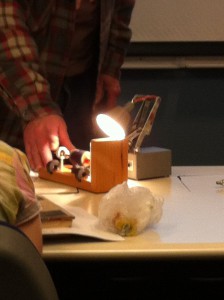For the experiment portion of our last class, we were lucky enough to be visited by Suffolk University employee and electrical enthusiast, Tom Vales, along with his awe-inspiring creations designed as alternatives to fossil fuels. As Mr. Vales provided us with a preface to his presentation, he noted that we as a society are “addicted” to the usage of coal and oil, despite the number of ingenious inventions we have at our disposal. The first energy alternative Mr. Vales showed us was called Peltier junction, which he had fastened together from a few metals, copper, water, and two coffee cups. The Peltier junction, as Mr. Vales explained, used heat in one cup and cold water in the other to produce electricity through the running motor; although the energy produced from this invention is not an efficient amount, it is ideal for smaller purposes such as beverage coolers in automobiles.
Traveling down the line of his displayed contraptions, Mr. Vales next presented to us what he identified as the Stirling engine, which was invented in 1816 as a substitution for steam engines due to their notorious habit of exploding from overheating. This creation runs off a cup of hot water – as the displacer moves up and down, the invention’s piston circulates hot air, which is what gave the contraption its alternate name, the hot air engine. According to Mr. Vales, this form of energy production is quite efficient, as submarines tend to use it in their generator to reduce the expelled noise level.
The next contraption Mr. Vales explained is commonly seen in household kitchens, and its internal function goes beyond the simplistic nature of its purpose: the barbecue lighter sparks its useful flame thanks to the Piezo effect taking place within its small, plastic body, as friction against the embedded piece of quartz crystal creates voltage. This same method of energy production was used for portable radios in the past.
The final creation displayed on the front table was described as the Mendocino motor from its birthplace fifteen years ago in California. This small contraption is equipped with a rotor that

floats within a magnetic field against gravity. Once a light source is applied to the motor’s four solar cells, the light energy causes the motor to spin rapidly. Mr. Vales lightheartedly revealed that he frequently makes these Mendocino motors and sells them over the Internet to be used as decorative pieces, although, as he joked, no one with a curious cat should own one of these spinning inventions.
Throughout the presentation thus far, the entire class had been peeking at the object placed behind Mr. Vales that resembled a spool of coppery twine placed atop a white gallon container. At this time, Mr. Vales began to introduce this contraption by giving us a brief history of the famous electrical engineer, Nicola Tesla, who emigrated from Serbia in 1880 to become one of the greatest contributors to the advancement of electricity. Through his work with financer George Westinghouse, Tesla was able to invent the power grid and therefore provide electrification for Niagra Falls through the transmission of power without wires – it is this invention that stood before us in the classroom, as recreated by Mr. Vales. Once he flipped the power switch, the parts of the contraption known as the Tesla coils began to produce a mesmerizing purple static spark at the top.
Keeping the contraption on, Mr. Vales demonstrated how different objects react once they get close enough to the powerful Tesla coils; at one point, he held up two different tubes to the sparking contraption, and the class watched in awe as the tube filled with xenon suddenly

illuminated to a bluish color, and the tube with two different diameters lit up pink in one half and blue in the other. Mr. Vales also demonstrated placing a Z-shaped wire on top of the contraption – once the power had been turned back on, the wire stayed atop the coil and began to spin clockwise at a rapid speed. This presentation was a treat for our class, and we were very appreciative as well as entertained by Mr. Vales visit. To view Mr. Vales’s experience with electricity and electrical devices, look for his electrical show in the springtime at Suffolk University.